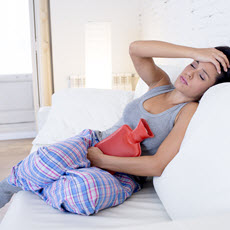Menstrual clots are a mixture of blood cells, tissue from the lining of the uterus, and proteins in the blood that help regulate its flow.
Some medical conditions can cause large blood clots, often alongside heavy menstrual bleeding or period pains.
Causes of menstrual clots
During menstruation, the endometrial cells that line the uterus strip away and leave the body.
As this happens, the body releases proteins that cause the blood in the uterus to coagulate. This coagulation prevents the blood vessels in the uterine lining from continuing to bleed.
The blood that the body has already shed also contains these coagulation proteins.
When the flow is most substantial, the coagulation proteins within the blood may start to clump together, resulting in menstrual clots.
This generally occurs when menstrual blood pools in the uterus or genital before leaving the body.
Possible health conditions
Although it is normal to have clots in the blood during menstruation, this symptom can sometimes signal a medical issue. It is advisable to seek medical advice if the clots:
1. are larger than a quarter in size
2. are very frequent
3. occur with an abnormally heavy flow that requires a person to change their pad or tampon at least every 1–2 hours
4. occur with significant pain.
The following conditions may cause abnormal menstrual clots:
Uterine polyps or fibroids
A blockage in the uterus may stop it from contracting as it should, meaning that it cannot force the blood out as quickly as usual. The blood will leave the body more slowly so it will have more time to pool and form clumps.
The blockage can also cause a heavier flow, which results in more blood pooling.
Blockages may occur as a result of growths in the uterus. These include uterine polyps and fibroids, which are not cancerous but can cause other health issues without proper management.
Uterine polyps and fibroids consist of either endometrial or muscular tissue that grows in the uterine wall.
Endometriosis
Photo credit: Medicalnewstoday
Endometriosis can cause painful and heavy periods.
Endometriosis is a condition that causes the tissues of the uterine lining to grow outside of the uterus.
This abnormality can lead to several symptoms, which may be worse around the time of menstruation.
Symptoms of endometriosis often include:
1. pain and cramping in the pelvis or lower back
2. very heavy periods, or menorrhagia
3. painful periods, or dysmenorrhea
4. discomfort or pain during Intercourse
5. fertility issues.
Adenomyosis
In people with adenomyosis, the uterine lining grows into the muscular wall of the uterus.
This can make the endometrial lining and uterine wall much thicker, which can lead to a much heavier flow during a period.
As a result, it is more likely that blood clots will appear in the menstrual blood.
Hormonal imbalances
The balance of hormones in the body is essential for maintaining a healthy uterus.
If the levels of specific hormones become unbalanced, many issues can occur, including heavy menstruation or clotting.
Enlarged uterus
After pregnancy, a person’s uterus often remains somewhat larger than it was before. An enlarged uterus can also be due to structural issues, such as fibroids.
There will be additional space for the blood to pool in, which could lead to further clotting before it exits the body.
Bleeding disorders
Some bleeding disorders may be responsible for heavy menstrual flow, as they can affect the coagulation proteins that the uterine lining needs to stop menstrual bleeding.
Disorders such as platelet function disorder or von Willebrand’s disease (VWD) may cause abnormally heavy menstruation.
 Home Of Ghana News Ghana News, Entertainment And More
Home Of Ghana News Ghana News, Entertainment And More





